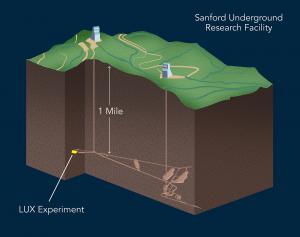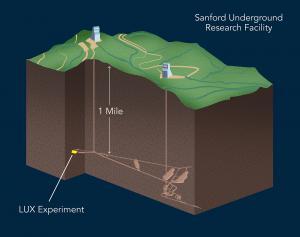LUX Research

The Large Underground Xenon (LUX) experiment with an active mass of 250 kg is the US predecessor experiment to LZ. It has been operating in the Davis Campus of the Sanford Underground Research Facility in the former Homestake Gold Mine since 2013. Scientists had significantly enhanced its ability to look for WIMPs, or weakly interacting massive particles, which are among the leading candidates for dark matter.
Dark Matter Detection
LUX consists of a quarter of a ton of liquid xenon surrounded by sensitive light detectors (Photomultiplier Tubes, or PMTs), and is designed to detect collisions of dark matter particles with xenon atoms. When this happens, the xenon will recoil and emit a faint flash of light, which is detected by the PMTs. The detector’s location at Sanford Lab beneath a mile of rock helps to shield it from cosmic rays and other radiation that would interfere with a dark matter signal.
LUX has yet to detect a dark matter signal, but its exquisite sensitivity has allowed scientists to rule out a vast range of properties WIMPs could have potentially had. New calibration techniques increase that sensitivity even further, particularly for low WIMP masses.

LUX Research at SLAC
SLAC has played an instrumental role in the analysis, both in terms of fully understanding the detector signals, background sources, and in carefully calculating the detector’s sensitivity to dark matter. One study looked in detail at the response to residual radioactivity on the chamber walls that is inevitably deposited by radon progeny during detector construction. In the improved analysis of the 2013 LUX data, this model allowed us to loosen some of our selection criteria for WIMPs. Another study developed a better way to quantify the PMT signal size for the smallest energy events in the xenon, helping to take advantage of improved low energy calibrations. SLAC scientists also developed an improved implementation of the statistical framework that more readily allows for different WIMP signal models to be tested for in the data. Many of these techniques will continue to be used and expanded upon as we focus on the second science run of LUX, which will complete in 2016.

In late 2016, LUX will be decommissioned to make way for the much larger xenon detector of the LUX-ZEPLIN (LZ) experiment, which will be filled with 10 tons of liquid xenon – thirty times the volume used for LUX. SLAC's LZ Group, led by Dan Akerib and Tom Shutt, are working on a purification system that will be 20 times faster and produce 100 times purer liquid xenon than the one used for LUX. Because of the very effective shielding properties of the xenon, the inner sensitive region of LZ will outweigh LUX by fifty times. All of LZ's xenon will be purified at SLAC. The group has also assembled a prototype for the LZ detector, which is 100 times more sensitive to elusive WIMPs compared to LUX.


